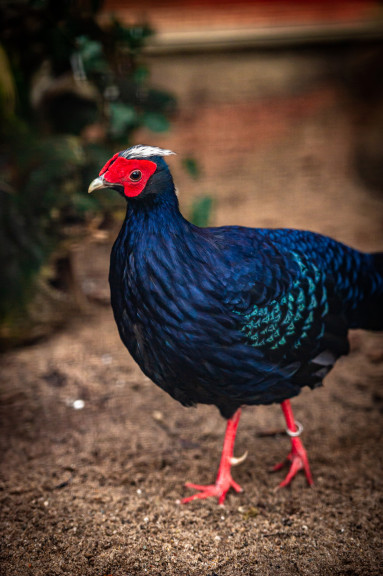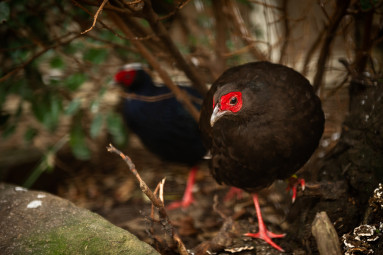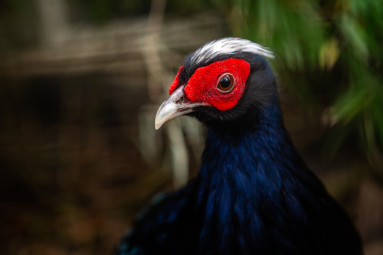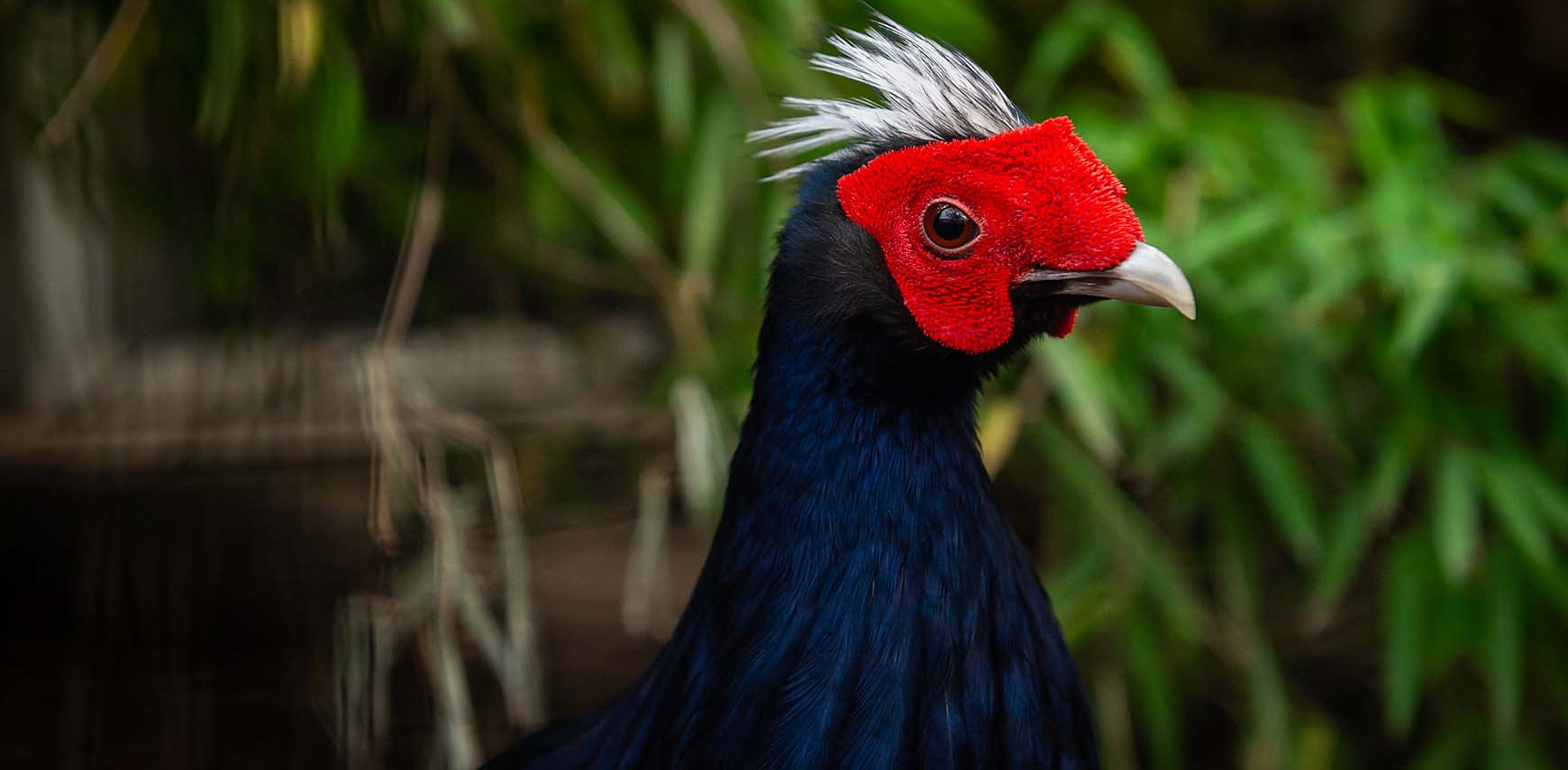The extinct Vietnamese pheasant will fly home again
Antwerp ZOO helps presumed extinct species return to the wild
Considering that the Vietnamese pheasant has not been spotted in its natural habitat since the beginning of this century, Antwerp ZOO is taking targeted action. Thanks to an international breeding programme and accompanying reintroduction project, this remarkable bird will soon have a new chance to thrive in the forests of its native Vietnam. Antwerp ZOO is contributing to the reintroduction of this species into the wild. Genetic research by our own scientists also revealed that one of the Vietnamese pheasant pairs bred at Antwerp ZOO is a perfect match for reintroduction into their native habitat in Vietnam.
A unique yet mysterious species
Despite its size, the Vietnamese pheasant went largely unnoticed by the zoological world for a long time. The species – which remains something of a mystery – was, in fact, not officially discovered until the late 19th century. ‘Scientists have never been able to study this species in its natural habitat. Our knowledge of the Vietnamese pheasant comes solely from observations in zoos and from local bird collectors in the past,’ explains Jan Dams, Curator of Birds at Antwerp ZOO and Chair of the Galliformes Taxon Advisory Group (TAG), an advisory body focused on a specific animal group – in this case, Galliformes, a family of heavy-bodied, ground-dwelling birds – within the European Association of Zoos and Aquariums (EAZA).
‘We humans have made life incredibly difficult for this species. It is our responsibility to make things right.’ - Jan Dams, Curator of Birds at Antwerp ZOO and Chair of the Galliformes Taxon Advisory Group (TAG)
The Vietnamese pheasant is a lowland species that inhabits valleys and riverbanks – areas severely affected by deforestation and agriculture. The forests of Central Vietnam were also heavily impacted by the Vietnam War. Defoliants such as Agent Orange, along with napalm bombings and the resulting fires, rendered their habitat uninhabitable. ‘We humans have made life incredibly difficult for this species. It is our responsibility to make things right,’ stresses Dams.

Urgent action needed
No valuable time can be wasted in our efforts to save the Vietnamese pheasant from extinction. In 2024, the species received a grim update on the IUCN Red List. This list assesses the extent to which a species is endangered on the basis of extensive criteria. The Vietnamese pheasant is now classified as ‘critically endangered, possibly extinct in the wild’, with an estimated wild population of no more than 0 to 49 individuals. ‘Time is running out for the Vietnamese pheasant, but if we act decisively, we may still be able to save the species from extinction.’
Fortunately, it’s not entirely too late. ‘The global population of Vietnamese pheasants is currently around 1,000 individuals, all of which are kept in zoos or by private individuals and can be used to help save the species.’ These 1,000 birds are all descended from a founding stock of 26 animals imported by the legendary aviculturist Jean Delacour, who brought them to his estate in the French village of Clères. From here, they were dispersed around the world. Sadly, a war also disrupted progress here: during World War II, the European Vietnamese pheasant population collapsed. However, thanks to a number of breeders, it was later revived, and there is now hope for a successful reintroduction into the wild.
So, how do you go about saving a species from extinction? It is not as easy as it may seem. In fact, it is a gigantic project that hinges upon a diversity of decisive factors.

Optimising genetic diversity
Genetic diversity is essential for the successful reintroduction of a species. The broader the genetic pool, the better the population can adapt to a new environment. Thanks to the approximately 1,000 Vietnamese pheasants around the world – 370 of which are cared for under the European Ex-situ Programme (EEP) in zoos – we have a strong foundation for recovery. However, not all birds will be eligible for the programme.
‘At present, Antwerp ZOO is closely examining the genetic aspect and working to determine the best way to prepare for the reintroduction of this species into the wild. A narrow genetic base would make the process much more difficult, so a genetically diverse population is crucial.’
‘One pair of birds currently living in Planckendael ZOO but born in Antwerp ZOO will be sent to Vietnam. This is fantastic news!’ - Jan Dams
Initially, the team will identify which animals are of genetic significance to the preservation of the species and should ideally be represented in the future population in Vietnam. To do this, they are using genomic techniques (next-gen ddRAD sequencing) to assess the genetic purity of the animals, followed by genetic analysis to examine their lineage. Based on the data obtained, breeding recommendations can then be made. Which animals should definitely be sent to Vietnam? Which males are the best match for which females? Taking all of this into consideration, the scientists at Antwerp ZOO carefully considered all the options and created a list.
‘One pair of birds currently living in Planckendael ZOO but born in Antwerp ZOO will be sent to Vietnam. This is fantastic news!’ says Dams. The birds will be given a home in Vietnam, where their offspring will be prepared for life in the wild. Ultimately, these young Vietnamese pheasants will be released into the forests of Vietnam.
Where will they end up?
Not only does the programme require a breeding centre, but also a natural habitat in which the birds can be safely reintroduced. ‘The damage to their natural habitat is severe. There are still many barren patches where no plants or trees can grow because the soil is so heavily contaminated. Fortunately, there are still a few nature reserves where the environment remains intact, and where we can safely release the animals into the wild.’
However, there is a long-standing tradition in Vietnam of sourcing protein from the forest. The local population does this by setting small snares to catch animals. These traps are both easy and inexpensive to make. ‘We will need to address this issue before reintroducing the birds into the wild. This brings us to another important point: cooperation with local communities. We need to ensure they have alternative sources of protein, engage with them actively, and help them understand the importance of biodiversity.’
Travelling to Vietnam
Soon, the pair of Vietnamese pheasants from Planckendael Zoo will embark on their journey to Vietnam, specifically to the Vinpearl Safaripark in Phú Quốc. There, they will be quarantined before being transferred to the breeding centre. ‘The next step is breeding chicks from these pairs, with the first hatching hopefully in 2025 or 2026. These young birds will eventually be released into the wild.
This process will involve a significant learning curve: ‘Once the population in Vietnam is large enough, we will begin monitoring them. The birds will be equipped with trackers to monitor their movements, survival, and breeding activity. This data will allow us to adjust our strategy as needed.’

Collaboration for success
Apart from Antwerp ZOO, this programme involves a wide range of partners. These include organisations such as the EAZA Galliformes Taxon Advisory Group (TAG), the World Pheasant Association, and BirdLife International, along with zoos and prominent organisations in wildlife conservation – and, of course, local partners in Vietnam
‘In Vietnam, we collaborate with Viet Nature, a local NGO led by Pham Tuan Anh. She was the one who initially reached out to the European zoo community, and this is how we – as the Galliformes TAG – entered into contact with them, ultimately leading to the creation of our action plan.’
These organisations work together within the Vietnam Pheasant Recovery Team, of which Jan Dams of Antwerp ZOO is the chair. As a result, Antwerp ZOO plays a key role in the reintroduction of this species into the wild. The programme focuses on five key goals: (1) maintaining a healthy population of Vietnamese pheasants in a protected environment, (2) identifying, preparing, and managing suitable areas for their reintroduction into the wild, (3) successfully reintroducing the pheasants into an appropriate habitat, (4) increasing awareness of the species both locally and internationally, and (5) securing political and financial support for the project.
A clear focus
'The goal of the Vietnamese Pheasant Recovery Team is to establish three sustainable populations, each capable of maintaining itself without the need for further reintroductions, in three different locations. Our work won’t be finished, but it would be a huge step in the right direction.’ - Jan Dams
When can this reintroduction be considered a success? 'The goal of the Vietnamese Pheasant Recovery Team is to establish three sustainable populations, each capable of maintaining itself without the need for further reintroductions, in three different locations. By spreading populations across three sites, we can make sure that if problems arise in one region, two other populations will remain in a secure environment. Of course, our work won’t be finished, but it would be a huge step in the right direction.’
The successful reintroduction of the Vietnamese pheasant into the wild could have broader impacts. ‘By focusing on the Vietnamese pheasant, a well-known species within the conservation community, we aim to protect an entire region that is home to several other critically endangered species. The Vietnamese pheasant shares its habitat with the giant muntjac and the red-shanked douc. In fact, the saola – also known as the Vietnamese unicorn – has been spotted in this area as well. Through the Vietnamese pheasant project, we could potentially protect a whole range of other animals, plants, and local communities. Being part of such a project is a truly amazing experience,’ concludes Dams.
Complete list of partners: BirdLife International, Conservation Vietnam, Viet Nature, Critical Ecosystem Partnership Fund, Keidanren Nature Conservation Fund, IUCN Netherlands, World Pheasant Association, Mandai Nature, Stiftung Artenschutz, Wingham Wildlife Park UK, World Land Trust, KNCF, Zoo Karlsruhe, Paignton Zoo, Prague Zoo, VINACONSERV, WPA, Zoo en Tierpark Berlin, Zoological Society of London, Chester Zoo en Zoo Antwerpen.

